A 10-Year Statistic Study on the Tornadoes That Occurred in Jiangsu and Zhejiang Province: Composite Background Environment and Linear Trends
Abstract
1. Introduction
2. Data and Method
3. Spatiotemporal Features
4. Universal Features of the Background Environment
4.1. Configuration of Different Vertical Levels
4.2. Surface Features
4.3. Vertical Profiles
5. Trend Analyses
6. Conclusions and Discussion
Author Contributions
Funding
Institutional Review Board Statement
Informed Consent Statement
Data Availability Statement
Acknowledgments
Conflicts of Interest
References
- Markowski, P.; Richardson, Y. Mesoscale Meteorology in Midlatitudes; Wiley-Blackwell: Hoboken, NJ, USA, 2010; p. 407. [Google Scholar]
- Davies-Jones, R.; Trapp, R.J.; Bluestein, H.B. Tornadoes and tornadic storms. In Severe Convective Storms; Doswell, C.A., Ed.; American Meteorological Society: Boston, MA, USA, 2001; pp. 167–221. [Google Scholar] [CrossRef]
- Dawson, D.T.; Xue, M.; Shapiro, A.; Milbrandt, J.A.; Schenkman, A.D. Sensitivity of Real-Data Simulations of the 3 May 1999 Oklahoma City Tornadic Supercell and Associated Tornadoes to Multimoment Microphysics. Part II: Analysis of Buoyancy and Dynamic Pressure Forces in Simulated Tornado-Like Vortices. J. Atmos. Sci. 2016, 73, 1039–1061. [Google Scholar] [CrossRef]
- Edwards, R. Tropical Cyclone Tornadoes: A Review of Knowledge in Research and Prediction. Electron. J. Sev. Storms Meteorol. 2012, 7, 1–61. [Google Scholar] [CrossRef]
- Gallo, B.T.; Clark, A.J.; Dembek, S.R. Forecasting Tornadoes Using Convection-Permitting Ensembles. Weather Forecast. 2016, 31, 273–295. [Google Scholar] [CrossRef]
- Yu, X.D.; Zheng, Y.Y.; Liao, Y.F.; Yao, Y.Q.; Fang, C. Observational investigation of a tornadic heavy precipitation supercell storm. Chin. J. Atmos. Sci. 2008, 32, 508–522. [Google Scholar]
- Fan, W.J.; Yu, X.D. Characteristics of spatial temporal distribution of tornadoes in China. Meteor. Mon. 2015, 41, 793–805. [Google Scholar]
- Bai, L.; Meng, Z.; Sueki, K.; Chen, G.; Zhou, R. Climatology of tropical cyclone tornadoes in China from 2006 to 2018. Sci. China Earth Sci. 2019, 63, 37–51. [Google Scholar] [CrossRef]
- Li, C.L.; Tan, H.B.; Cai, K.L.; Bai, L.Q.; Huang, X.X.; Yan, L.J.; Zhi, J.L.; Zhang, J.J. Tornadoes in China and their disaster characteristics from 2016 to 2020. J. Trop. Meteorol. 2021, 37, 733–747. [Google Scholar]
- Zhou, R.; Meng, Z.; Bai, L. Differences in tornado activities and key tornadic environments between China and the United States. Int. J. Clim. 2021, 42, 367–384. [Google Scholar] [CrossRef]
- Wang, X.M.; Yu, X.D. A study on the physical process involved in the genesis of a severe tropical tornado. Acta Meteorol. Sin. 2019, 77, 387–404. [Google Scholar]
- Meng, Z.; Yao, D. Damage Survey, Radar, and Environment Analyses on the First-Ever Documented Tornado in Beijing during the Heavy Rainfall Event of 21 July 2012. Weather Forecast. 2014, 29, 702–724. [Google Scholar] [CrossRef]
- Bai, L.; Meng, Z.; Huang, L.; Yan, L.; Li, Z.; Mai, X.; Huang, Y.; Yao, D.; Wang, X. An Integrated Damage, Visual, and Radar Analysis of the 2015 Foshan, Guangdong, EF3 Tornado in China Produced by the Landfalling Typhoon Mujigae (2015). Bull. Am. Meteorol. Soc. 2017, 98, 2619–2640. [Google Scholar] [CrossRef]
- Xue, M.; Zhao, K.; Wang, M.; Li, Z.; Zheng, Y. Recent significant tornadoes in China. Adv. Atmos. Sci. 2016, 33, 1209–1217. [Google Scholar] [CrossRef]
- Zhou, R.L.; Meng, Z.Y.; Bai, L.Q. Chinese Tornado Dataset (2007~2016), Peking University Open Research Data Platform. 2020. Available online: https://opendata.pku.edu.cn/dataverse/pku;jsessionid=fa4ee10bc7095fe987980a4dd800?q=&fq0=fileAccess%3A%22Public%22&fq2=publicationDate%3A%222020%22&types=dataverses%3Afiles&sort=dateSort&order=desc (accessed on 5 April 2022).
- Fujita, T.T. Tornadoes and Downbursts in the Context of Generalized Planetary Scales. J. Atmos. Sci. 1981, 38, 1511–1534. [Google Scholar] [CrossRef]
- Hersbach, H.; Bell, B.; Berrisford, P.; Hirahara, S.; Horányi, A.; Munoz-Sabater, J.; Nicolas, J.; Peubey, C.; Radu, R.; Schepers, D.; et al. The ERA5 global reanalysis. Q. J. R. Meteorol. Soc. 2020, 146, 1999–2049. [Google Scholar] [CrossRef]
- Fu, S.-M.; Zhang, J.-P.; Sun, J.-H.; Zhao, T.-B. Composite Analysis of Long-Lived Mesoscale Vortices over the Middle Reaches of the Yangtze River Valley: Octant Features and Evolution Mechanisms. J. Clim. 2016, 29, 761–781. [Google Scholar] [CrossRef]
- Zhang, Y.-C.; Fu, S.-M.; Sun, J.-H.; Fu, R.; Jin, S.-L.; Ji, D.-S. A 14-year statistics-based semi-idealized modeling study on the formation of a type of heavy rain–producing southwest vortex. Atmos. Sci. Lett. 2019, 2019, e894. [Google Scholar] [CrossRef]
- Mai, Z.; Fu, S.; Sun, J.; Hu, L.; Wang, X. Key statistical characteristics of the mesoscale convective systems generated over the Tibetan Plateau and their relationship to precipitation and southwest vortices. Int. J. Clim. 2020, 36, 3148–3160. [Google Scholar] [CrossRef]
- Wang, H.; Sun, J.; Fu, S.; Zhang, Y. Typical Circulation Patterns and Associated Mechanisms for Persistent Heavy Rainfall Events over Yangtze-Huaihe River Valley during 1981–2020. Adv. Atmos. Sci. 2021, 38, 2167–2182. [Google Scholar] [CrossRef]
- Fu, S.; Mai, Z.; Sun, J.; Tang, H. On the physical significance and use of a set of horizontal and vertical helicity budget equations. Atmos. Ocean. Sci. Lett. 2019, 12, 417–423. [Google Scholar] [CrossRef]
- Fu, S.; Li, W.; Sun, J.; Zhang, J.; Zhang, Y. Universal evolution mechanisms and energy conversion characteristics of long-lived mesoscale vortices over the Sichuan Basin. Atmos. Sci. Lett. 2014, 16, 127–134. [Google Scholar] [CrossRef]
- Fu, S.-M.; Sun, J.-H.; Luo, Y.-L.; Zhang, Y.-C. Formation of Long-Lived Summertime Mesoscale Vortices over Central East China: Semi-Idealized Simulations Based on a 14-Year Vortex Statistic. J. Atmos. Sci. 2017, 74, 3955–3979. [Google Scholar]
- Feng, S.-L.; Jin, S.-L.; Fu, S.-M.; Sun, J.-H.; Zhang, Y.-C. Formation of a kind of heavy-precipitation-producing mesoscale vortex around the Sichuan Basin: An along-track vorticity budget analysis. Atmos. Sci. Lett. 2019, 2019, e949. [Google Scholar] [CrossRef]
- Fu, S.-M.; Mai, Z.; Sun, J.-H.; Li, W.-L.; Ding, Y.; Wang, Y.-Q. Impacts of convective activity over the Tibetan Plateau on plateau vortex, southwest vortex, and downstream precipitation. J. Atmos. Sci. 2019, 76, 3803–3830. [Google Scholar] [CrossRef]
- Fu, S.-M.; Zhang, J.-P.; Tang, H.; Jiang, L.-Z.; Sun, J.-H. A new mesoscale-vortex identification metric: Restricted vorticity and its application. Environ. Res. Lett. 2020, 15, 124053. [Google Scholar] [CrossRef]
- Fu, S.-M.; Tang, J.-H.; Sun, T.-B.; Zhao, W.-L.; Li, H. Historical rankings and vortices’ activities of the extreme Mei-yu seasons: Contrast 2020 to previous Mei-yu seasons. Geophys. Res. Lett. 2021, 49, e2021GL096590. [Google Scholar] [CrossRef]
- Fu, S.; Mai, Z.; Sun, J.; Li, W.; Zhong, Q.; Sun, J.; Zhang, Y. A semi-idealized modeling study on the long-lived eastward propagating mesoscale convective system over the Tibetan Plateau. Sci. China Earth Sci. 2021, 64, 1996–2014. [Google Scholar] [CrossRef]
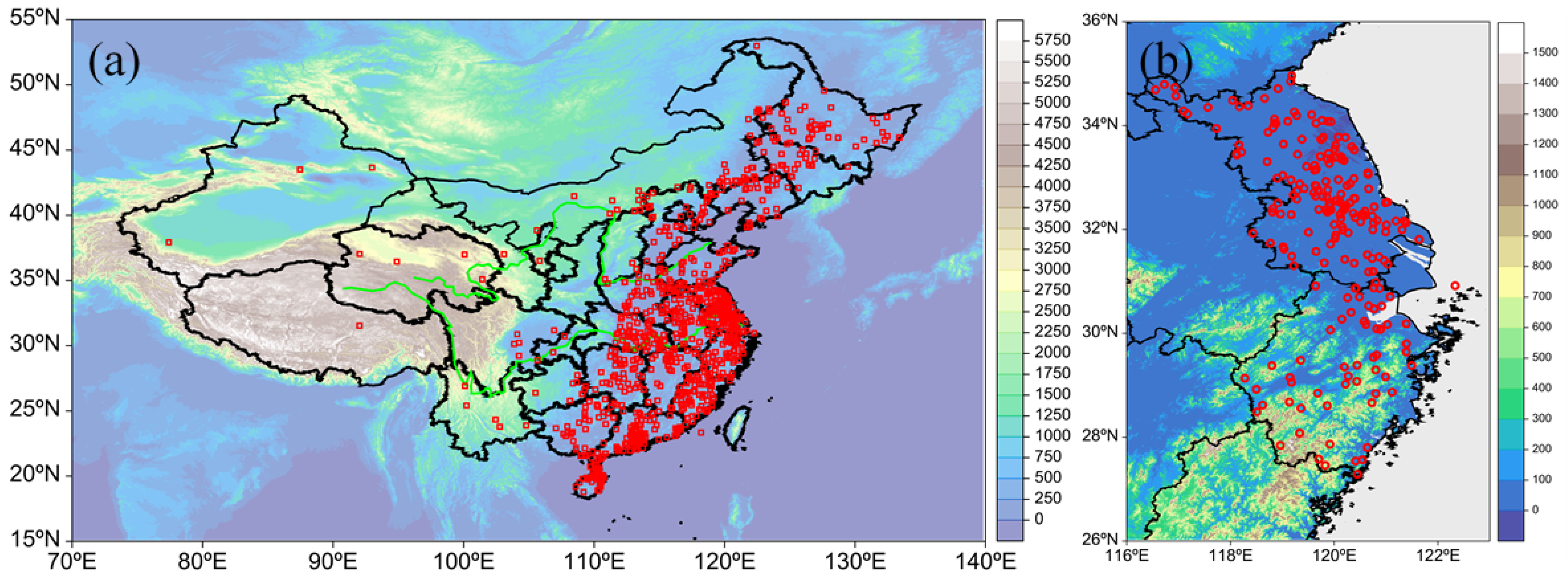

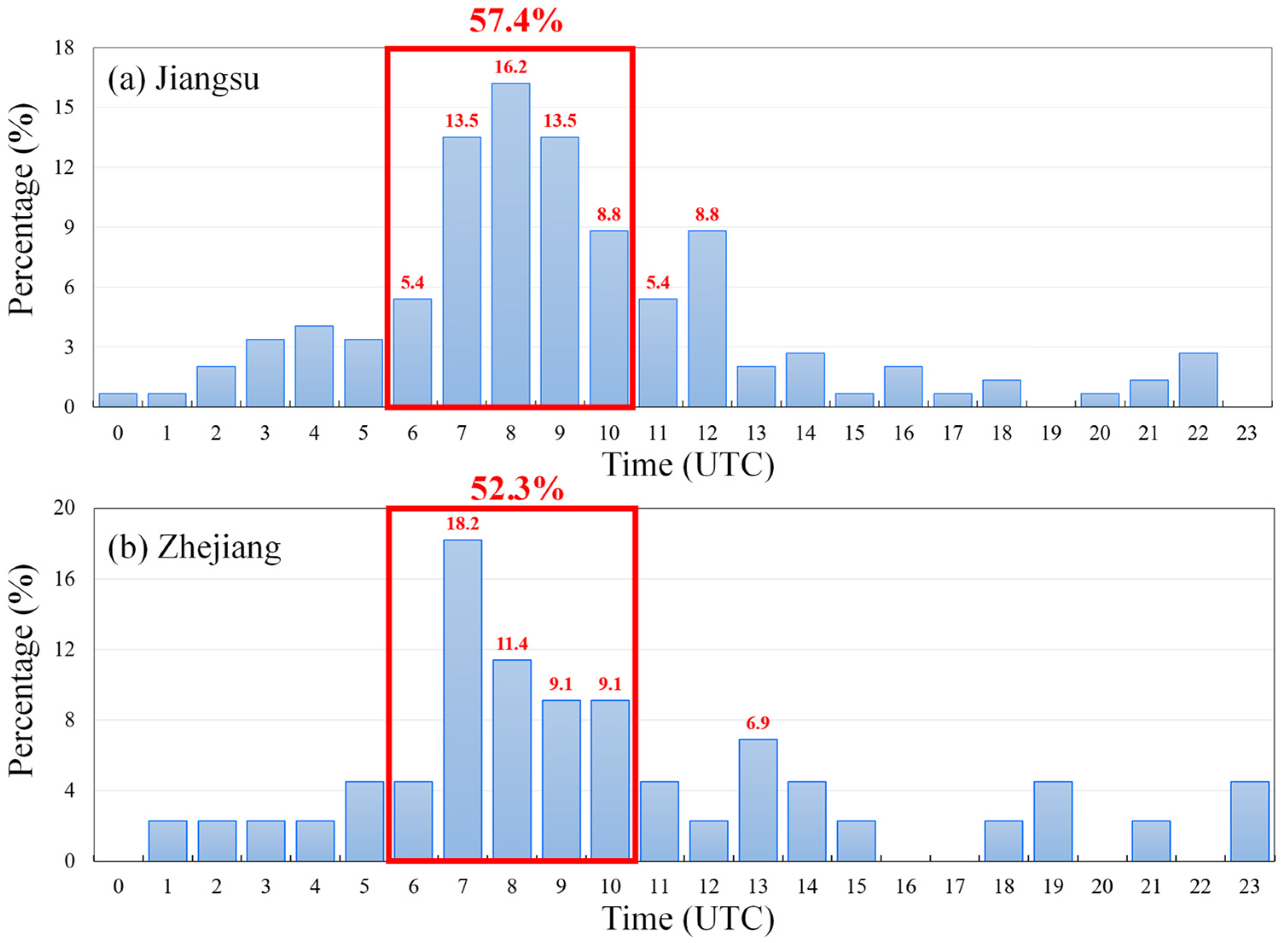
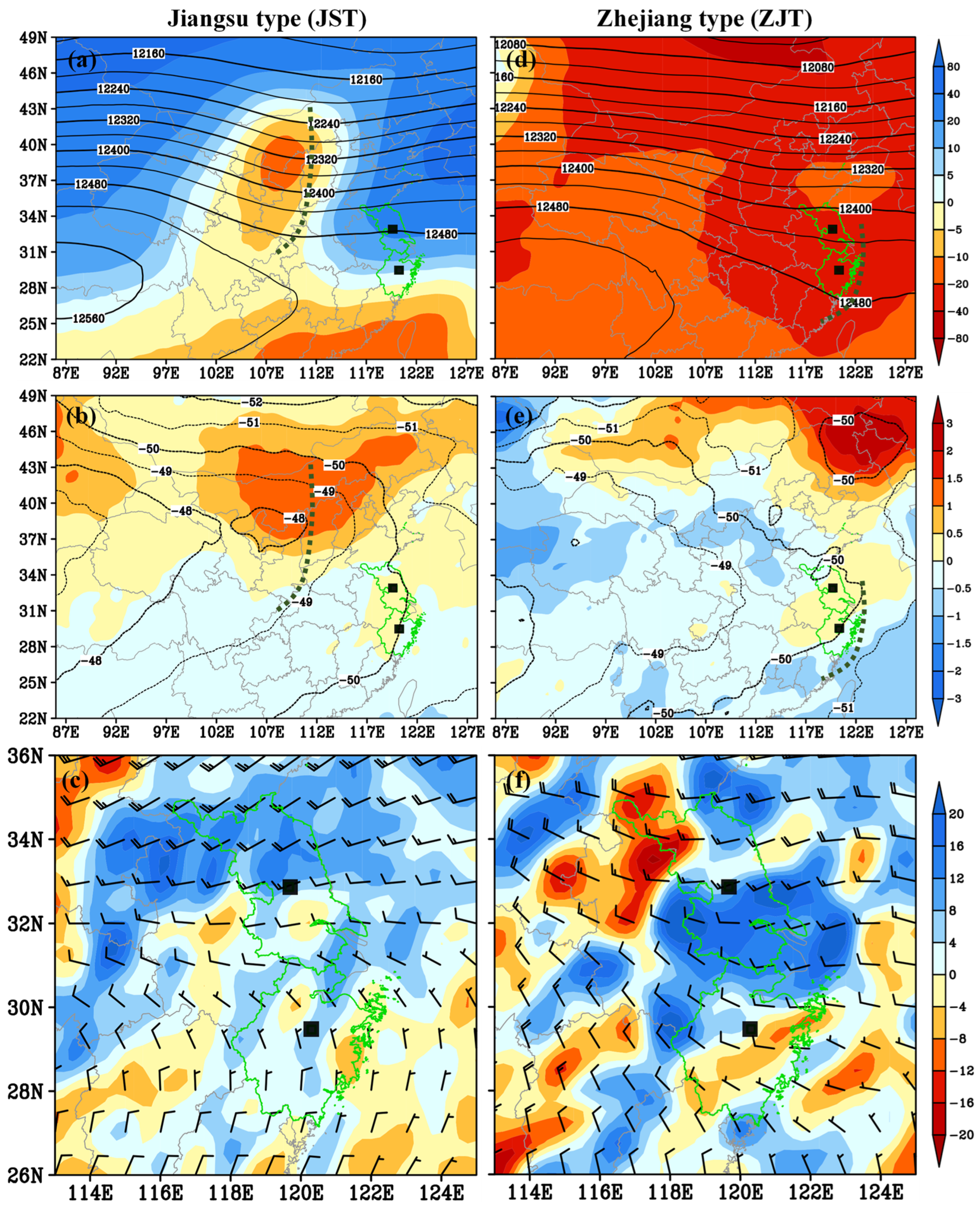
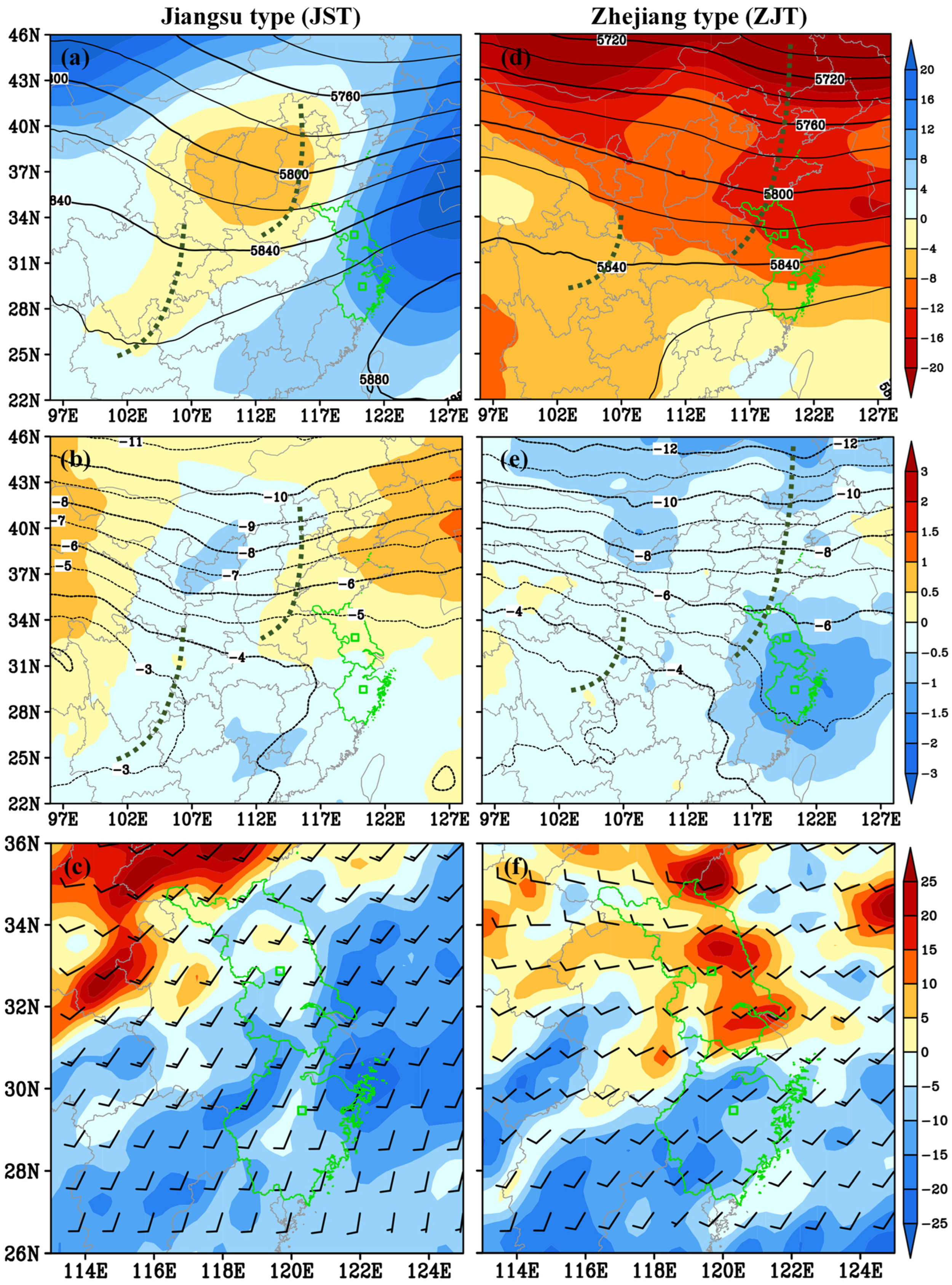

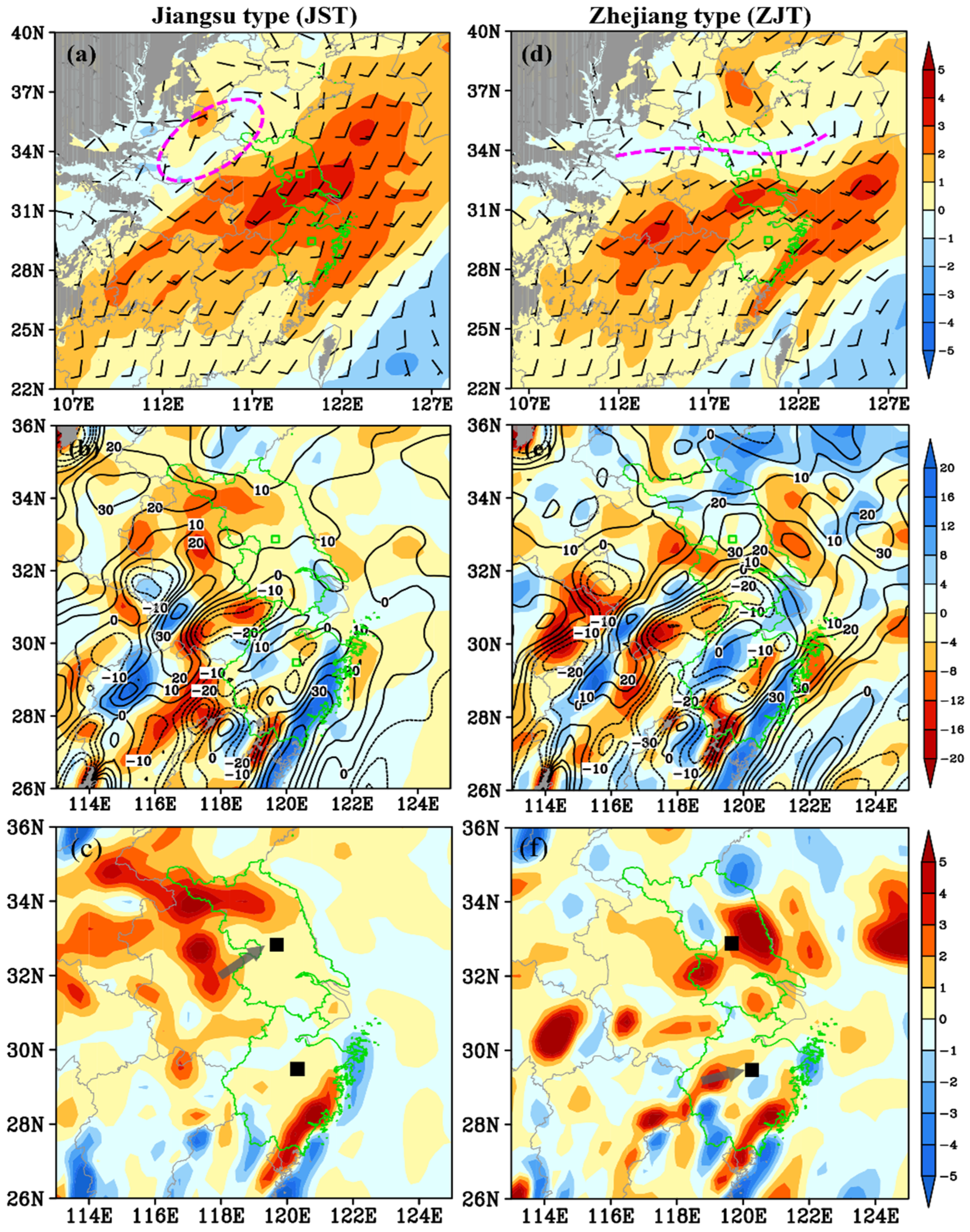
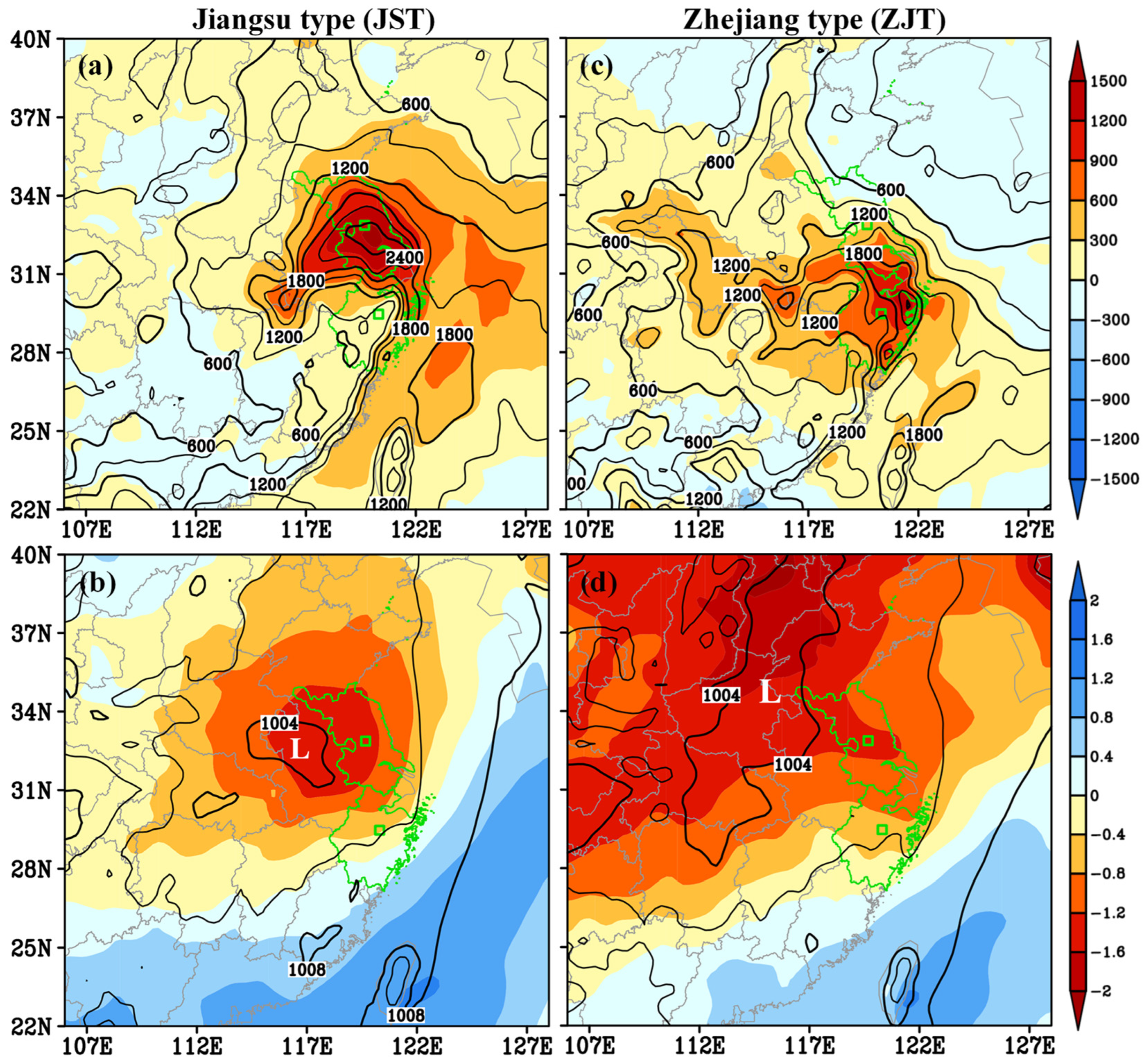
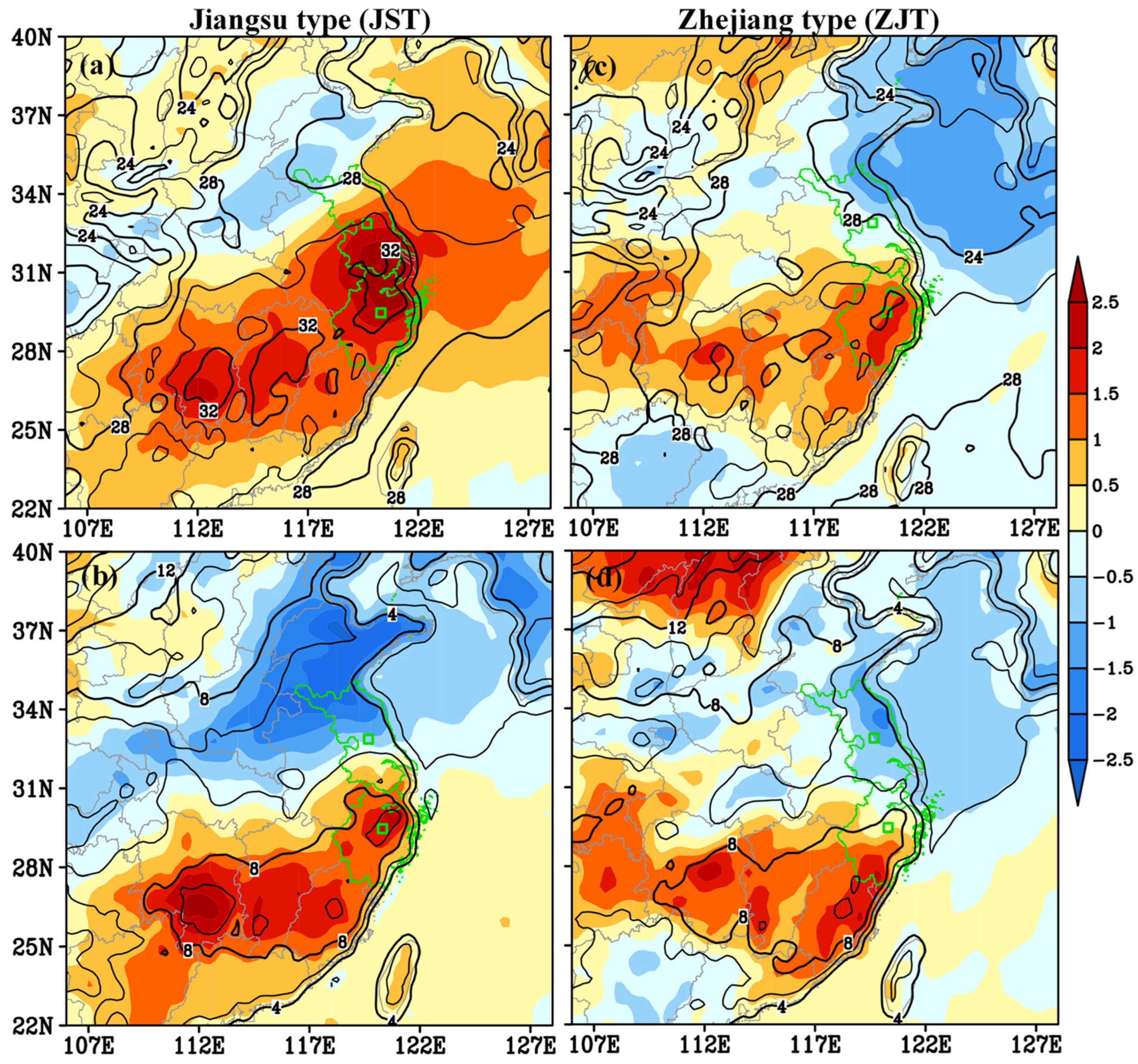
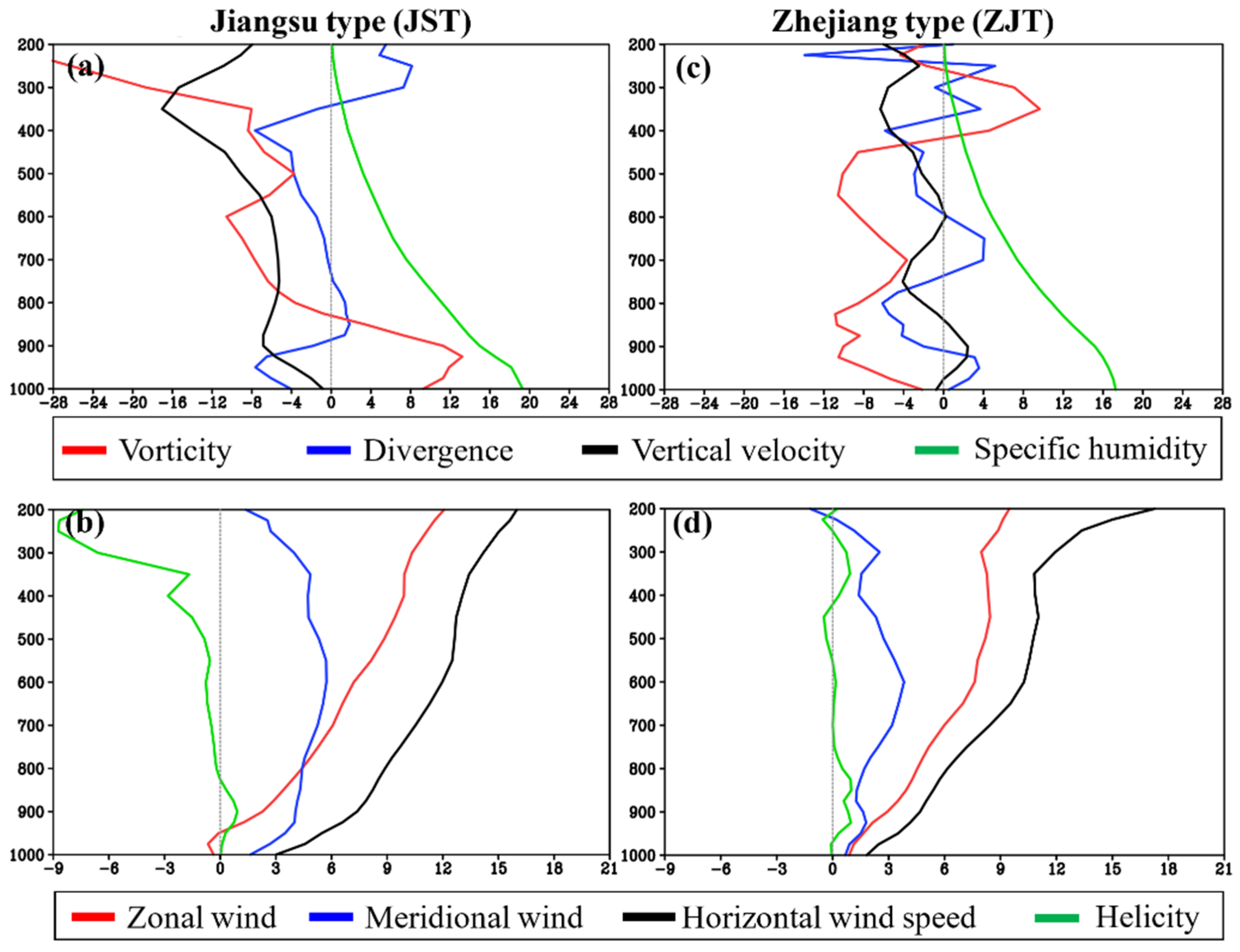
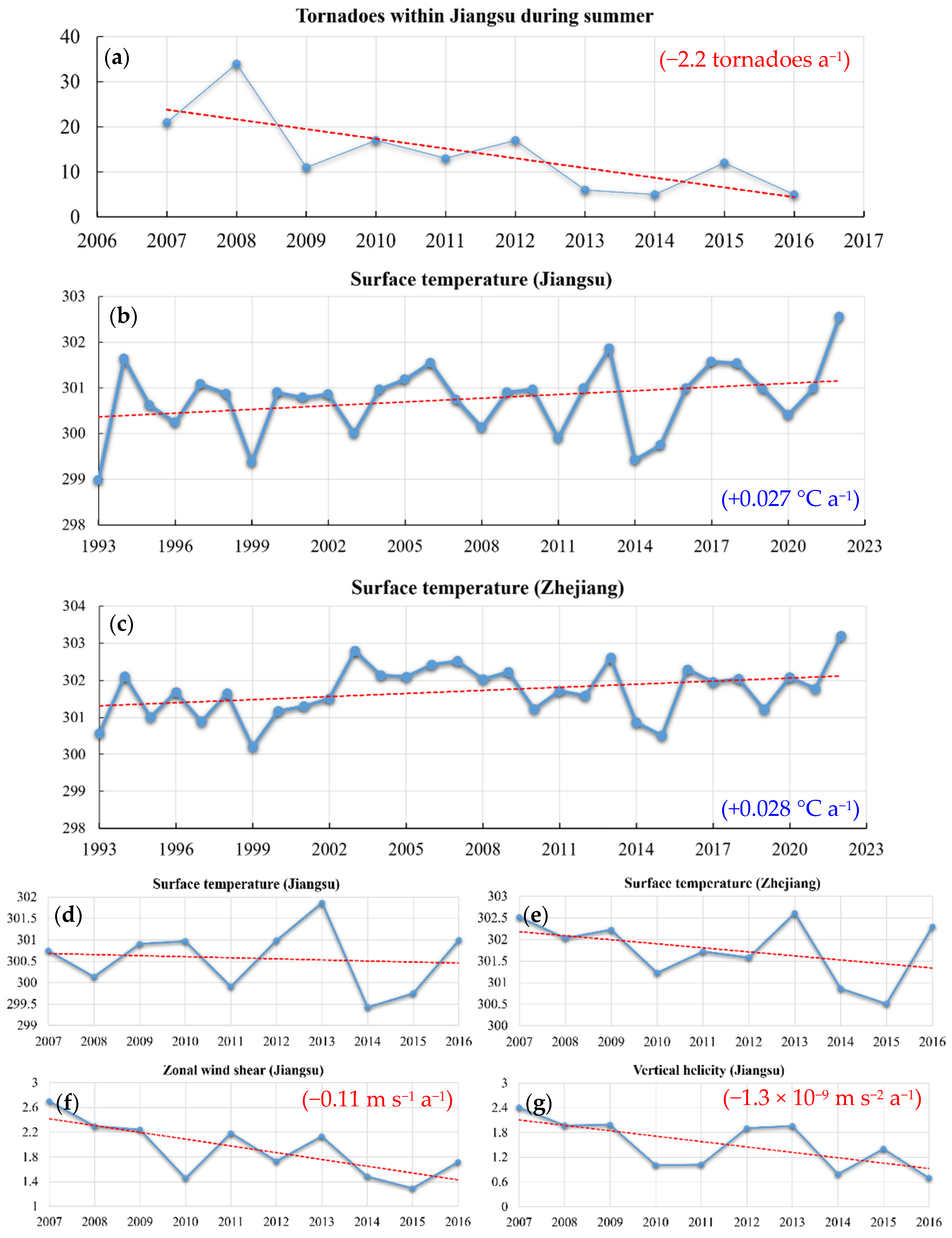
| CAPE | HEL | ZWS | MWS | SLP | SUT | DTD | |
|---|---|---|---|---|---|---|---|
| Jiangsu | 0.25 | 0.52 | 0.74 | 0.48 | 0.12 | −0.13 | 0.29 |
| Zhejiang | 0.26 | 0.18 | 0.34 | 0.15 | 0.24 | 0.22 | 0.23 |
Publisher’s Note: MDPI stays neutral with regard to jurisdictional claims in published maps and institutional affiliations. |
© 2022 by the authors. Licensee MDPI, Basel, Switzerland. This article is an open access article distributed under the terms and conditions of the Creative Commons Attribution (CC BY) license (https://creativecommons.org/licenses/by/4.0/).
Share and Cite
Li, D.; Liu, J.; Liu, B.; Jiang, W.; Zhou, X.; Gao, C.; Wang, Z.; Bai, C. A 10-Year Statistic Study on the Tornadoes That Occurred in Jiangsu and Zhejiang Province: Composite Background Environment and Linear Trends. Sustainability 2022, 14, 16766. https://doi.org/10.3390/su142416766
Li D, Liu J, Liu B, Jiang W, Zhou X, Gao C, Wang Z, Bai C. A 10-Year Statistic Study on the Tornadoes That Occurred in Jiangsu and Zhejiang Province: Composite Background Environment and Linear Trends. Sustainability. 2022; 14(24):16766. https://doi.org/10.3390/su142416766
Chicago/Turabian StyleLi, Danyu, Jinghua Liu, Bin Liu, Wendong Jiang, Xiaoyu Zhou, Chao Gao, Zhenguo Wang, and Cang Bai. 2022. "A 10-Year Statistic Study on the Tornadoes That Occurred in Jiangsu and Zhejiang Province: Composite Background Environment and Linear Trends" Sustainability 14, no. 24: 16766. https://doi.org/10.3390/su142416766
APA StyleLi, D., Liu, J., Liu, B., Jiang, W., Zhou, X., Gao, C., Wang, Z., & Bai, C. (2022). A 10-Year Statistic Study on the Tornadoes That Occurred in Jiangsu and Zhejiang Province: Composite Background Environment and Linear Trends. Sustainability, 14(24), 16766. https://doi.org/10.3390/su142416766






